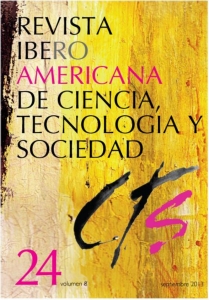Critical theory of technology:
an approach from engineering
DOI:
https://doi.org/10.52712/issn.1850-0013-626Keywords:
critical theory of technology, technical code, engineering, designAbstract
A critical theory of technology was proposed by the American philosopher of technology Andrew Feenberg in his 1991 book Critical Theory of Technology. In the two decades since its first formulation, the theory was enriched with three other texts by the same author (Feenberg, 1995, 1999 and 2002) and by an important series of articles that explain it and put it in dialogue and discussion with other streams of thinking about technology. While the horizon that Professor Feenberg was aiming for is more ambitious than the mere description of the technological phenomenon, its proposal for a new formulation of socialism should always include technology as a central aspect. Thus, the “instrumentalization theory” bears a scope that not only includes the theory of democracy but also the design theory. On this last point, it is particularly relevant to study the relationship between engineering and the critical theory of technology. Elucidating a possible relationship and discussing its scope is the objective of this work.
Downloads
References
BIJKER, W.; HUGHES, T. y PINCH, T. (1994): The Social Construction of Technological Systems: New Directions in the Sociology and History of Technology, Massachusetts, MIT Press.
BUCCIARELLI, L. (1994): Designing Engineers, Massachusetts, MIT Press.
DYM, C. y LITTLE, P. (2006): El proceso de diseño en ingeniería: Cómo desarrollar soluciones efectivas, México, Limusa Wiley.
FEENBERG, A. (2005): “Teoría Crítica de la Tecnología”, Revista Iberoamericana de Ciencia, Tecnología y Sociedad -CTS, vol. 2, nº 5, pp. 109-123.
FEENBERG, A. (2002): Transforming Technology: A critical theory revisited, Nueva York, Oxford University Press.
FEENBERG, A. (1999): Questioning Technology, Nueva York, Routledge.
FEENBERG, A. (1995): Alternative Modernity: The technical turn in philosophy and social theory, Los Ángeles, University of California Press.
FEENBERG, A. (1991): Critical Theory of Technology, Nueva York, Oxford University Press.
FENG, P. y FEENBERG, A. (2009): “Thinking about design: Critical theory of technology and the design process”, en P. Vermaas et al (coord.): Philosophy and Design: From engineering to architecture, USA, Springer, pp. 105-118.
FERGUSON, E. (1999): Engineering and the Mind´s Eye, Massachusetts, MIT Press.
FRIEDMAN, B.; KAHN, P. y BORNING, A. (2002): “Value Sensitive Design: Theory and methods”, Technical Report 02-12-01, Department of Computer Science & Egineering, University of Washington.
KRICK, E. (2005): Introducción a la ingeniería y al diseño en ingeniería, México, Limusa.
KROES, P. (2009): “Foundational issues of engineering design”, en A. Meijers (ed.): Philosophy of technology and engineering sciences, USA, North Holland.
KROES, P. (1998): “Technological explanations: The relation between structure and function of technological objects”, Phil & Tech, vol. 3, nº 3, pp. 18-34.
PITT, J. (2000): Thinking About Technology, Foundations of the Philosophy of Technology, Michigan, Seven Bridges Press.
SIMONDON, G. (2008): El modo de existencia de los objetos técnicos, Buenos Aires, Prometeo.
VAN DE POEL, I. (2009): “Values in Engineering Design”, en A. Meijers (ed.): Philosophy of technology and engineering sciences, USA, North Holland.
VEAK, T. (2006): Democratizing Technology: Andew Feenberg´s Critical Theory of Technology, Albany, State University of New York Press.
VINCENTI, W. (1993): What Engineers Know and How They Know It: Analytical Studies from Aeronautical History, Baltimore, Johns Hopkins University Press.
Downloads
Published
How to Cite
Issue
Section
License
Copyright (c) 2024 CC Attribution 4.0

This work is licensed under a Creative Commons Attribution 4.0 International License.
All CTS's issues and academic articles are under a CC-BY license.
Since 2007, CTS has provided open and free access to all its contents, including the complete archive of its quarterly edition and the different products presented in its electronic platform. This decision is based on the belief that offering free access to published materials helps to build a greater and better exchange of knowledge.
In turn, for the quarterly edition, CTS allows institutional and thematic repositories, as well as personal web pages, to self-archive articles in their post-print or editorial version, immediately after the publication of the final version of each issue and under the condition that a link to the original source will be incorporated into the self-archive.











